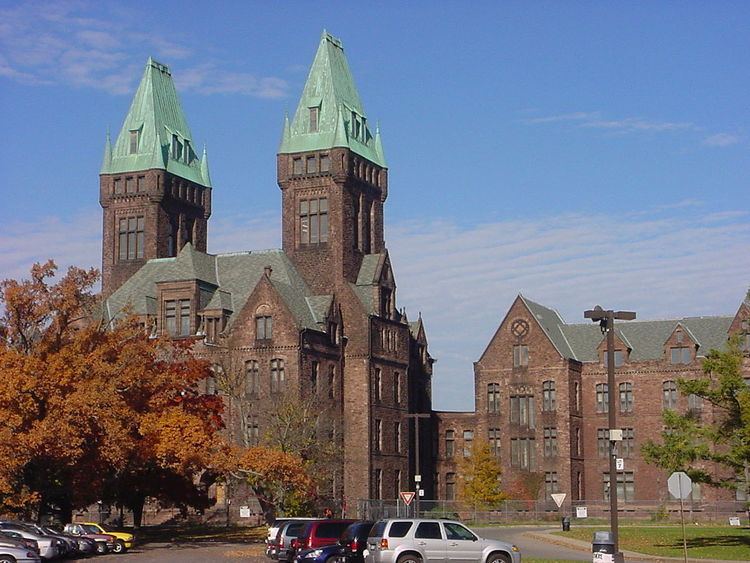NRHP Reference # 73001186 Designated NHL June 24, 1986 Phone +1 716-601-1150 | Added to NRHP January 12, 1973 Area 38 ha Year built 1870 | |
 | ||
Address 444 Forest Ave, Buffalo, NY 14213, USA Similar Danvers State Hospital, Buffalo Central Terminal, Prudential (Guaranty) Building, Willard Asylum for the Chron, Delaware Park–Front Park Syst Profiles | ||
The richardson olmsted complex
The Richardson Olmsted Complex in Buffalo, New York, United States was designated a National Historic Landmark in 1986. The site was designed by the American architect, Henry Hobson Richardson, in concert with the famed landscape team of Frederick Law Olmsted and Calvert Vaux in the late 1800s, incorporating a system of enlightened treatment for people with mental illness developed by Dr. Thomas Story Kirkbride. Over the years, as mental health treatment changed and resources were diverted, the buildings and grounds began a slow deterioration. In 2006, the Richardson Center Corporation was formed with a mandate to save the buildings and bring the Complex back to life through a State appropriation for this architectural treasure.
Contents
- The richardson olmsted complex
- Insane asylum richardson olmsted complex
- Architecture
- Preservation efforts
- Adaptive reuse plans
- References
Today, the Richardson Olmsted Complex is being transformed into a cultural amenity for the city, beginning with Hotel Henry Urban Resort and Conference Center and the Buffalo Architecture Center in the iconic Towers Building and two flanking buildings (about one third of the Complex). The remaining buildings have been stabilized pending future opportunities.
Insane asylum richardson olmsted complex
Architecture
The large Medina red sandstone and brick hospital buildings were designed in 1870 in the Kirkbride Plan by architect Henry Hobson Richardson with grounds by landscape architect Frederick Law Olmsted. The complex consists of a central administrative tower and five pavilions or wards progressively set back on each side, for eleven buildings total, all connected by short curved two-story corridors. Patients were segregated by sex, males on the east side, females on the west. The wards housed patients until the mid-1970s. The central administration building was used for offices until 1994. In 1973, the Asylum was added to the National Register of Historic Places and in 1986, it was designated a National Historic Landmark.
The complex, the largest commission of Richardson's career, marks the advent of his characteristic Romanesque Revival style. When emulated by later architects, this style is referred to as Richardsonian Romanesque. It has been the subject of a long-term preservation campaign. Nevertheless, three pavilions on the east side were demolished in the 1970s to make way for newer psychiatric facilities. In 1927, the northern farmlands were transferred back to the State for the development of what is today Buffalo State College.
Patient records from 1881 to 1975 are in the collection of the New York State Archives in Albany, NY.
Preservation efforts
A successful lawsuit filed by the Preservation Coalition of Erie County (renamed "Preservation Buffalo Niagara" in October 2008) forced the State of New York to commit $100 million to its rehabilitation. Both former New York State Assembly Member Sam Hoyt and former Buffalo State College President Muriel A. Howard were actively involved in plans for the restoration and reuse of the Complex. As a result, the State established the Richardson Center Corporation in 2006 to rehabilitate the Complex. Perimeter fencing and lighting have been installed and a Peace Officer is on duty at all times to conduct regular patrols of the area to prevent and deter crime.
On March 5, 2008, stabilization began with the most severely damaged buildings, including the roof and down-spouts. Stabilization was completed in 2012.
On April 10, 2010, a two-alarm fire occurred. The cause of the fire was under investigation. Damage was estimated at $200,000.
In 2013, the South Lawn landscape on the property was completed. The re-greening of the nine-acre South Lawn transformed two large parking lots at the Complex’s south entry into a welcoming space for community gathering and recreation.
At every stage of planning, the Richardson Center Corporation has used an active public process, which has helped to inform the Master Plan and all phases of redevelopment for the Complex. Ten public meetings have taken place since 2007 to inform the planning and reuse. A Community Advisory Group includes representatives from the adjacent neighborhoods, business districts, cultural institutions, Buffalo Psychiatric Center, SUNY Buffalo State, and historic preservation groups.
Adaptive reuse plans
On January 25, 2013, Phase I plans were announced to redevelop 1/3 of the Complex into hotel, event and conference space and the Buffalo Architecture Center. This first phase of redevelopment will be completed in 2016 and Hotel Henry and the architecture center will open in 2017.
